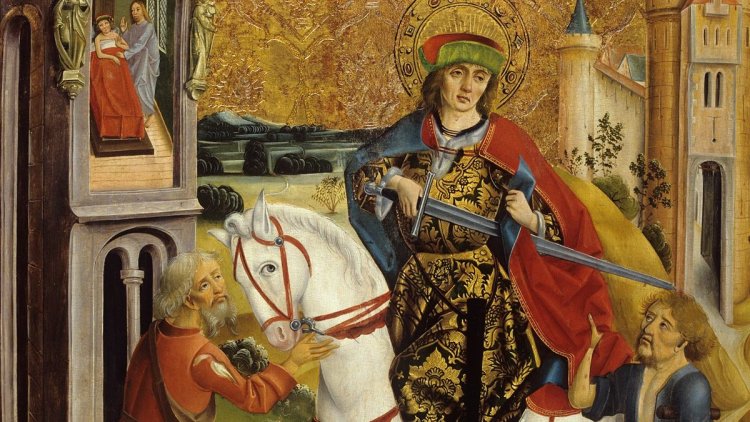In the wake of St. Martin's Day - Saint of the Soldiers and a feast of geese. Written by Anna Szentei.
November 11 is St. Martin's Day, which is the last big Dinomdanom time before the forty-day fasting period before Christmas: the ancients celebrated the holiday with goose pies and new wine, and so do we, because even today's world cannot resist the cheerful mind and spirit.
But what do we actually celebrate on St. Martin's Day? Why is roast goose among the traditional dishes served at this time? And who do we honor in the person of Saint Martin?
Many folk customs and beliefs are connected to Martin's day, the roots of which go back to ancient times. November 11 was the beginning of the winter quarter in Roman times, and the tradition of a goose sacrifice dedicated to Aesculapius, the god of healing, is connected to this day; among the dishes of the feast held at that time, the goose was featured in the main dish. Centuries later, Martin's day, the celebration of one of the most beloved saints of the Middle Ages, Saint Martin, who began his earthly career as a soldier and ended as a saint, was built on this tradition.
Many stories are related to Martin's day, according to one of them, when the rogue Gauls wanted to attack Rome under the cover of night, the geese of the Capitol alerted the guards with their cackling - in the tradition of the time, the goose was considered the sacred bird of Mars. Perhaps it was this ancient story that also coincided with a legend related to Saint Martin: in 371, when the Christians wanted to elect him bishop of Tours, Martin did not want to accept the profession - he imagined his life as a simple priest, not as a high church dignitary - so he went into hiding in the goose shed, but the loud cackling of the animals revealed his hiding place.
Half cloak
Saint Martin of Tours (316-397) was also a popular saint in our country: he is the patron saint of soldiers, beggars and goose keepers, the second most important saint after the Virgin Mary, and in this capacity we can also honor him as the patron saint of Hungary. His ancient biographer places the place of St. Martin's birth in the area of Savaria (in later language, Sabaria, today's Szombathely), St. István built the Benedictine abbey of Szentmártonhegy, i.e. Pannonhalm, in his honor. During the war with Koppany, the founding king of our state prayed to the saint, and before going into battle he painted the image of the soldier saint on his flags.

Saint Martin's veneration became common throughout the country from the decades of the 10th century, he was popularly chosen as the patron saint of churches. His most popular medieval depiction captures the event that took place near Amiens in today's France, when Saint Martin, as a soldier of the Roman legion, met a cold beggar at the city gate during the winter flood, took pity on him, and gave half of his cloak to the beggar, splitting it in two.
According to the legend, the trembling beggar was Jesus Christ himself, who appeared in Martin's dream that night, so the young soldier decided to serve God as a result of the experience. He left the Roman legion, was baptized, then began to convert - he joined Saint Hilary of Poitiers - and from 371 he served as bishop of Tours. He went to rest at an unusually high age at the time, at the age of 81. He was canonized shortly after his death, and his resting place in Tours soon became a famous place of pilgrimage. It is interesting that, despite the fact that the name was borne by a saint, the name Márton remained popular in the Reformed and Lutheran areas after the spread of Protestantism, which may have had something to do with the respect for Márton Luther, the founder of the Reformation.
Those who don't eat goose...
In the middle of November, we are slowly saying goodbye to autumn, and nature is showing its increasingly grim face. At this time, the crops had already been harvested, this period marked the end of the economic year in the folk tradition, the settlement and the time of paying off the serf debt, then the annual allowance of the shepherds, canas and kondas, as well as the "mártongaras", were paid, and the judges were elected in the villages from among themselves for the New Year, and the shepherds gave a cane - St. Martin's cane - to the farmer as a gift. They believed that as many branches as Márton's cane has, so many piglets, that is, the pig has a son. Even in the spring, the cane played an important role: it was used to drive the animals out to the pasture.
St. Martin's Day is the last holiday before the Advent period before Christmas, when the big tract is still allowed: at this time, feasts and balls were held, in fact, it was considered that whoever "does not eat goose on St. Martin's Day, goes hungry all year round." Of course, "Saint Martin is the judge" of wine too, and the farmers tasted the new wine at this time. And, of course, similarly to the majority of important days, this was also a day of prohibition: it was forbidden to clean and wash, otherwise imprudent householders risked the destruction of their goods.
Countless weather forecasting customs were also associated with St. Martin's Day. It was believed that if the breastbone of the roast goose is brown and short, then the winter will be gray, if it is white and long, then it will be snowy. And of course, if "the goose walks on ice on St. Martin's Day, it splashes in water at Christmas." Similar to these weather forecasting customs, they were also associated with Catherine's Day on November 25: "if Catherine knocks, Christmas will rain", i.e. if it's freezing in November, Christmas will certainly not be white.
Even from this narrow list, one can sense how many folk customs and beliefs were connected to St. Martin's Day, in the depths of which lay the wise adaptation to the rhythm of nature that repeats itself year after year, and the deep sacredness that permeates everyday life.
Featured image: S. Bartels/Pixabay/AI













